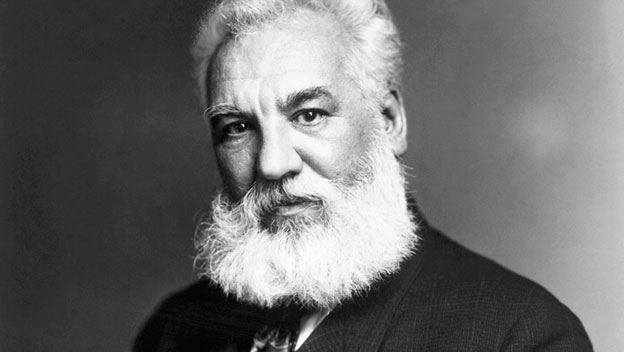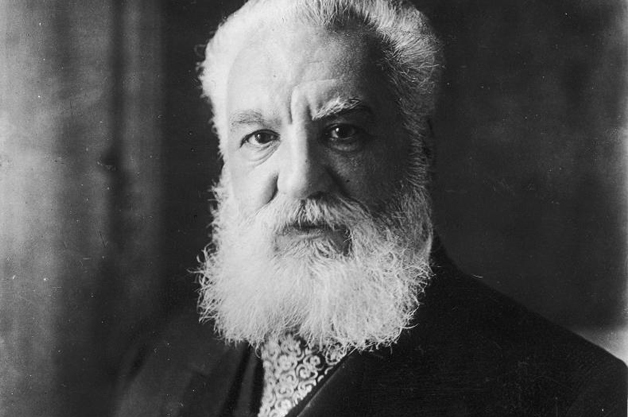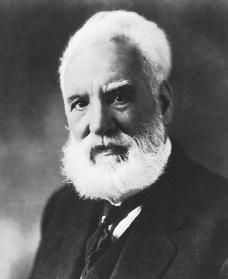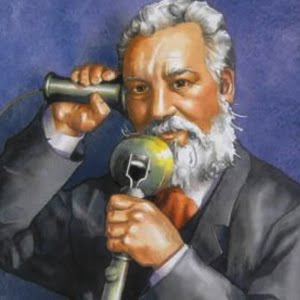Alexander Graham Bell
Alexander Graham Bell ( March 3, 1847 in Edinburgh, Scotland; † August 2, 1922 in Baddeck, Canada ) was a British and later American speech therapist, inventor and big business. He is considered the first man who has capitalized on the invention of the telephone by advanced ideas of his predecessors to the market. In his honor, the dimensionless unit ( Pseudomaß ) for logarithmic ratio values , which also measuring sound levels, named Bel.
Life
Bell, who was initially taught as his two brothers by the mother, attended from the age of 10, a private school in Edinburgh and from the age of 14, a school in London. He studied in Edinburgh Latin and Greek. Already grandfather Alexander and his father, Alexander Melville Bell dealt with speech technology, the latter being the first universal phonetic writing system or a phonetic spelling or phonetic alphabet developed as a professor of speech and elocution, he Visible Speech called, because thus the sounds were mapped.
Son Alexander, who even as a child took the surname Graham in admiration for a friend of the family, was 17 years old teacher at the Weston House Academy for elocution and music in Elgin, Scotland. During this time his first independent research began in the field of acoustics. He also learned the German physicist and physiologist Hermann von Helmholtz know, the " doctrine of the sensations of tone as a physiological basis for the theory of music," the young Bell a major influence in his 1863 published work.
Finally, he followed his father to London, where this at University College worked as a teacher of elocution and hired his son as an assistant. Bell studied until 1870 anatomy and physiology of the human voice.
After Alexander's brothers Edward ( 1868) and Melville (1870 ) were both died of tuberculosis, settled Alexander and his parents in 1870 to Canada, where his father hoped for a better climate and a teaching activity recorded.
The historically most lasting effect had Bell in 1876 with the development and launch of the phone to a usable system. As a result, the Bell Telephone Company, which later developed into the world's largest telecommunications company AT & T was born.
In 1876 he married the deaf daughter of his business partner Mabel Hubbard, who he met as a deaf teacher at the Clarke School. With her he had two daughters, Elsie May and Marian ( Daisy ) Bell, and sons Edward and Robert, who both died in childhood.
1882 Bell received U.S. citizenship. Until his death in 1922, Bell was mainly involved with further developments and inventions in numerous technical fields as well as with studies on eugenics of deafness.
In 1890 he helped found the American Association to Promote the Teaching of Speech to the Deaf ( AAPTSD ) (now Alexander Graham Bell Association for the Deaf and Hard of Hearing ), whose first president was.
1897 Bell was elected after the death of Gardiner Greene Hubbard 's second president of the National Geographic Society.
Bell as a speech therapist and deaf teachers
Bells mother Eliza Symonds Bell was severely hard of hearing, however, Bell was able to talk to her with a particularly deep voice. In addition, she could feel the vibrations of his piano music. The family and the pre-cut career led Bell obviously, one of the most dedicated supporters to be the spoken language oriented educational principle for the Deaf as opposed to sign language -based methods.
1868 Bell gave to Susanna Hull's School in London elocution lessons for deaf-mute children. 1871 Bell went deaf as a teacher at the established in Northampton later " Clarke School " in Northampton (Massachusetts ). An air balloon that, each of these children held to the ear could pick up the vibrations in his voice. Bell then remains for the rest of his life a member of the Board of School and is in the last five years of life also its chairman. At this school he also learns Mabel, met his future wife. At the same time he also taught Edward Miner Gallaudet next at the American Asylum for the Deaf in Hartford (Connecticut).
From 1873 to 1877 he was professor of elocution and physiology of voice at the University of Boston.
Bell is said to have seen primarily as a deaf teacher and less than an inventor. An irony of history is that Bell, who always intended to promote the pigeons, with the phone used a system that has become a standard tool in professional, business and everyday life, but it was nearly a century for the deaf is not usable. However, recent technological developments (modern hearing aids, cochlear implant) also allow deaf to use the telephone.
Alexander G. Bell and the telephone
Bell's telephone had initially two previous developments as the basis.
In 1860, the Italian- American inventor Antonio Meucci had imagined a telephone set and 1871 found a patent application. For the final application as he could, who was then in a difficult economic situation, however, does not afford the cost and the validity of the reservation was extinguished in 1873. Meanwhile Bell, who now worked in the former workshops of Meucci was met with the materials and documents and she could use as a basis for his phone. As Meucci 1874 his equipment and documents demanded back, he was told that they had lost them. Meucci hired a lawyer to protest against Bell's approach, but this never happened. Despite decades of disputes failed Antonio Meucci, to obtain the patent or at least financial compensation from Bell. He died as an impoverished man. On 11 June 2002 the House of Representatives of the U.S. Congress of the United States praised the invention, and his work at the launch of the phone in a resolution Antonio Meucci.
From 1858 to 1863 Johann Philipp Reis had developed the first functioning device for transmitting sound via electrical lines and his invention given the name of " telephone ". On 26 October 1861 he led the telephone in front of numerous members of the Physical Society in Frankfurt. Rice took the Morse telegraph as a model that works with the open power supply circuit. Thus he was able to send sheet music to a receiver, but the device was for the language (yet) not suitable. After rice improved the apparatus until 1863 substantially and sold it in larger amounts than scientific demonstration object. So also copies came abroad.
Bell got an early model of the Reis'schen telephone set in 1862 know in Edinburgh. His father promised him and his brothers a prize if they would develop this talking machine. 1865 was able to achieve good results in England with the German " telephone " the British- American inventor David Edward Hughes. From 1868 worked in the U.S. with the German invention. When Bell Smithsonian Institution with the Reis'schen telephone experimented on the American research and educational institution in March 1875, the invention was already well known in the art and died rice for over a year. However, Bell was able to benefit from the important to him basic research of German.
1873 Bell tried to develop a " harmonic telegraph " which should be able to send multiple messages at the same time by using multiple isolated musical pitches, the operation but with little commitment. Bell 1874 operates by acoustic experiments for recording of sound waves. He designed so that the " Phonautographen ", a device that recorded the vibrations of the sound on a soot-covered cylinder.
The prominent Boston lawyer and co- director of " Clarke School for the Deaf " Gardiner Greene Hubbard and Thomas Sanders wealthy businessman from Salem learned of Bell's experiments and induced him to advance the development of the harmonic telegraph. The three signed an agreement, financial support after Bell received in return for future involvement of Hubbard and Sanders in the profits. Hubbard's daughter Mabel deaf was used as pressure medium. Bell she was allowed to marry until 1877, after he had completed his invention.
Although Bell is said to have discovered in his experiments by chance that instead of the expected Telegraph impulses tone sequences could be transferred, he was not able to repeat this discovery. Nevertheless, he said, to be able to describe the principle for the distribution of sound for a patent application. Benefited him with this is that the Patent Office a few years earlier had the request to drop to file with the patent application a working model. On February 14, 1876 filed Bells attorney Gardiner Greene Hubbard, the patent application for a just two hours before the teacher, inventor and entrepreneur, Elisha Gray was able to do the same. The main difference between the two telephones was that Bell's invention in contrast to that of Gray did not work. While Bell was also very vague in his request, Gray described his phone in to detailed font. Bells haste was not unfounded, he knew of several inventors who were also working on phones.
The application submitted by Hubbard triggered the largest patent dispute history. Bell used a variable resistor in the later practice of his phone and others. This was designed as a wire was dipped into a sulfur solution. Bell should have this resistance never tried before. In addition, this resistance was not included in his patent application. However, Elisha Gray's complaint contained such a resistance. Especially after Bell's patent was granted on March 7, 1876, the voices grew louder, who saw an illegal connection between Bell and the Patent Office. An official accused of corruption himself, but his fickle statement was doubted even in the international press.
Built by Bells knowledgeable mechanic Thomas A. Watson first working phone looked reportedly strange. The controversial patent dispute in acid- filled metal box was covered with a plate that held a wire that was immersed in the acid. The outside of the metal can, there was another wire, which leads to the recipient phone. The Roar Into in a vertically arranged above hopper mounted disc and wire to vibrate. By this vibration, the distance and thus also the current flow through the wire and to the acid modified recipient phone. There, the fluctuations in the current were converted back to similar membrane vibrations produced then tones. On March 10, 1876, the first clearly transmitted sentence to have been transmitted: " Watson, come here. I need you. " (Watson 'll come here, I need you). Bell is said to have accidentally poured acid over the clothes and called to Watson.
This phone was not very fit for use, but Bell is improved because he, unlike the Reis'schen sound transmission method, which was based on the vibration of a diaphragm, then used the electromagnetic induction, which the English physicist and chemist Michael Faraday (1791-1867) had discovered. Bell used now for both the speaker and the microphone electromagnetic coils, permanent magnets and the aforementioned resistance. In 1877 a new type of transducer was used, who used the pressure-dependent contact resistance between membrane and a piece of coal for signal acquisition. As the inventor of this carbon microphone, which is based on invented by Philipp Reis contact microphone, both the British-American engineer and inventor David Edward Hughes, who in 1865 experimented with an imported phone of the German and the German - American inventor Emil apply Berlin in 1877 during his at Bell Labs. Nevertheless, it took until 1881 until the Bell Telephone was virtually ready for use.
Bell as big business
In July 1877 Bell founded with Thomas Sanders and Gardiner Greene Hubbard including his assistant Thomas Watson, the Bell Telephone Company. Two days later, he married the deaf daughter of his business partner Mabel Hubbard, which he had previously trained as early as lip reading and speaking.
Not quite surprisingly, the demand for telephones was initially low and Bell and its partners initially had difficulties in selling. It came so far as to give up their patents to the mighty Western Union Telegraph Company - offered for $ 100,000 for sale - Elisha Gray's employers. The Western Union refused, what should prove to be a big mistake soon.
Nevertheless saw America's cable companies require that Bell's telephone was a threat to their business, and tried to counteract them. The Western Union Company was Thomas Alva Edison develop its own telephone with other technique. Bell sued Western Union for infringement of its patent rights. This tried to argue that actually Elisha Gray invented the telephone, but lost this and many other processes. Even Emil Berliner had trouble with the Patent Office and Thomas Edison, for his phonograph he had submitted entirely new ideas. Berlin had also developed a microphone that he 1877 for $ 50,000 to the " Bell Telephone Company " sold. He moved to Boston and worked for Bell Telephone until 1883.
In March 1879, the Bell Telephone Company merged with the New England Telephone Company for the National Bell Telephone Company, whose president, William H. Forbes, son of Ralph Waldo Emerson, was. In April 1880 a further merger with the American Speaking Telephone Company was the American Bell Telephone Company.
The American Telephone and Telegraph Company (AT & T) in New York was founded in 1885 as a subsidiary of Graham Bell, to capture the remote connection lines across the USA for the Bell's system. Theodore Vail was the first president of the society.
1889 all business activities of the American Bell Telephone Company for the American Telephone and Telegraph Company were transferred, as laws in Massachusetts would have prevented the aggressive growth. This marks the beginning of today's company AT & T.
1925 Bell Telephone Laboratories were constructed to summarize the research laboratories of the AT & T and Western Electric Company.
Other inventions
For his invention gave France Bell 1880 the Volta Prize, worth 50,000 francs. With this money he founded the Volta Laboratory in Washington, DC, where he and his assistant, Charles Sumner Tainter developed the photophone in the same year, using the light as a means of projecting the information while the phone was dependent on electricity. In 1881 they were able to successfully send a message using the photophone 200 yards from one building to another. Bell saw the photophone as "the greatest invention I have ever made ." The invention was the principle on which to base today's laser and fiber optics. 1886 invented Bell and his associates in the Volta Laboratory, the first roll, which could record on wax. You should, together with a flat wax disc, are the basis for the gramophone. In 1887 they sold their patent to the American Gramophone Company.
In addition to communicating Bell went to a wide variety of scientific experiments in which dragons, airplanes, tetrahedral structures, multiple births in sheep breeding, artificial respiration, as well as desalination and distillation of sea water played a role. The assassination of President Garfield in 1881 brought Bell on idea for the induction balance ( location of metal objects in the human body ). 1881 died Bells newborn son, Edward, to respiratory disease. Bell responded to this tragedy by inventing a metal vacuum jacket that would facilitate breathing. This apparatus was a forerunner of the iron lung, which was applied in the 1950s. Again and again he dealt with the numbness and developed the audiometer to measure hearing performance
1907 - four years after the first flight by the Wright Brothers in Kitty Hawk - Bell founded with Glenn Curtiss, William " Casey " Baldwin, Thomas Selfridge, and JAD McCurdy the Aerial Experiment Association. These young engineers had also to build the target is a flying machine. By 1909 they had built four wing aircraft, of which the best, " Silver Dart " the first successful flight on 23 February succeeded in Canada. He was of a frozen lake in Baddeck, Nova Scotia, started where Bell had a house.
Eugenics
AG Bell researched 1882-1892 the accumulation of deafness on Martha 's Vineyard near Boston, suspected behind it correctly hereditary systems. However, the relationships he could not prove because it irritated that not every child of apparently hereditary predisposed parents were deaf. He lacked this knowledge, the Gregor Mendel indeed already formulated in 1865, but remained largely unknown until the year 1900 to the public. Nevertheless, he recommended in the monograph Memoir upon the Formation of a Deaf Variety of the Human Race, a prohibition of marriage among deaf-mutes, warned against boarding the " deaf and dumb " schools as a possible breeding grounds of a deaf human race and recommended the eugenic control of U.S. immigrants.
Later work by Rassehygienikern supported up well into the 20th century RELIED on Bells information. As a result, numerous Dove were sterilized without their knowledge and without their consent. It should certainly have known the Bell methodological weaknesses of his inquiries.
1921 Bell was honorary president of the Second International Eugenikkongresses under the auspices of the American Museum of Natural History in New York. He worked with the organizations with the aim of introducing legislation to prevent the expansion of " defective races."
George Veditz, president of the National Association of the Deaf in 1907 called Bell " the enemy that have the most to fear the American pigeons ." Alexander Graham Bell shall thus have a reputation to have disrupted the development of the community of deaf people and sign language with massive impacts that are felt in many countries today.
Miscellaneous
- When Bell died in 1922, was resting in his memory in the United States for a minute, the entire telephone traffic.
- 1939 Don Ameche played him in the Hollywood biopic love and life of the phone maker A. Bell ( The Story of Alexander Graham Bell), directed by Irving Cummings.
- In honor of Bell and his invention was published in 1971 by the British glam rock band The Sweet Alexander Graham Bell the title, the place in Germany reached 24 in the charts. The rock group was given a gold record.
- In the Arctic archipelago Franz Josef Land, the Graham Bell Island and the local former Soviet air force base " Greem - Bell " named after Alexander Graham Bell. The island was discovered in 1899 by Evelyn Baldwin and designated by the expedition leader Walter Wellman.
- Bell was a co-founder of the international journal "Science".
- In his honor, the IEEE Alexander Graham Bell Medal is named, the highest award of the IEEE for telecommunications.
Prizes and awards
Writings
- Memoir upon the formation of a deaf variety of the human race. New Haven, CT: National Academy of Sciences. 1883 ( Notes to the formation of a deaf variation of the human race )
- Utility of signs, 1894 ( usefulness of sign )
- The question of sign language. 1898 ( The question of sign language )
- Marriage of the deaf. , 1917. ( Marriages of the deaf )
- Publications by Alexander Graham Bellim Internet Archive - online










